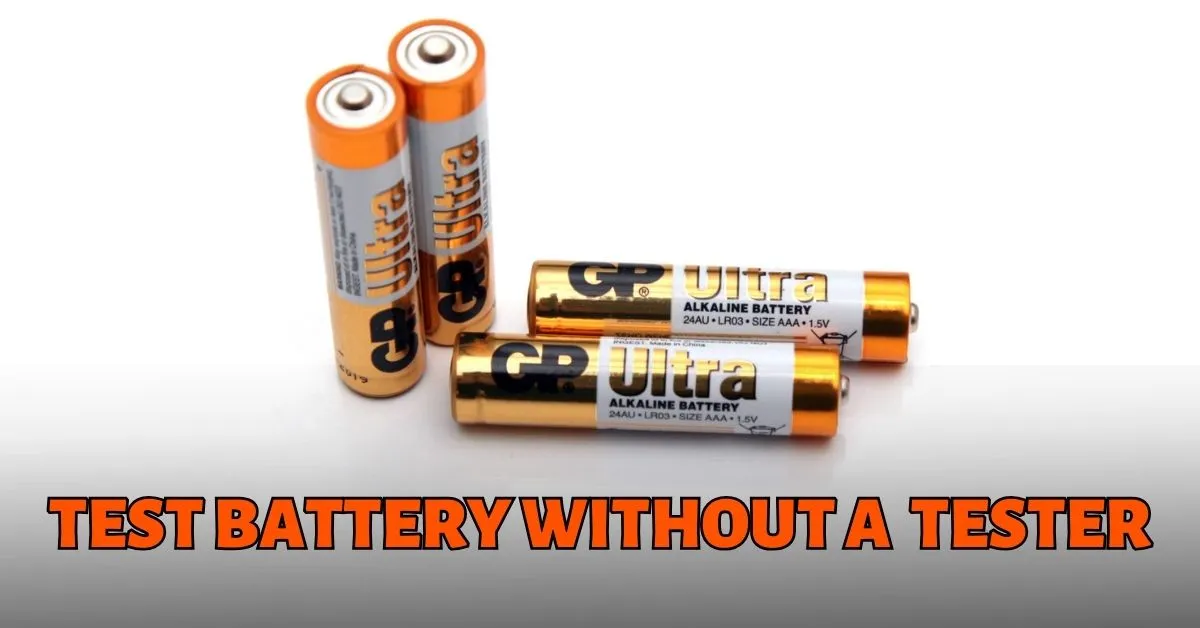What if I told you there’s a simple way to check if your batteries are still good, even if you don’t have a fancy tester? We’ve all been there: the TV remote stops working, the flashlight goes dim, or the car just won’t start. It’s often a battery issue.
Let’s unpack that. In this guide, we’ll show you easy tricks to test batteries without a tester or multimeter, from the small ones in your toys to the big one in your car.
Let’s get started!
Safety Precautions
Before diving deep into battery testing without a load tester, let’s have a heart-to-heart. Batteries, as powerful and useful as they are, come with their own risks. It’s crucial to approach them with respect and caution. Even the smallest of batteries can cause significant harm if mishandled. So, let’s set some ground rules:
- Handle with Care: Always remember batteries are not just another household item. They store energy, and mishandling can lead to unwanted reactions. Treat them with the care they deserve.
- Avoid Short-Circuiting: This might sound technical, but it’s straightforward. Ensure the positive and negative terminals of the battery never come in direct contact with each other or any conductive material. A short-circuit can cause the battery to heat up, leak, or even explode.
- Inspect Before You Test: Hear me out on this one. Before you even think of testing a battery, give it a good look. Is it leaking? Does it have any visible damage or bulges? If yes, it’s best to dispose of it safely and not risk testing.
How To Test Battery Without A Tester or Multimeter
These are the quick methods to test your battery without a load tester or multimeter:
- Visual Inspection: Sometimes, all it takes is a keen eye to spot signs of battery wear and tear.
- The Drop Test: A quick and easy method for alkaline batteries, revealing their health with a simple bounce (or lack thereof).
- The Flashlight Test: Using the power of light to illuminate a battery’s vitality.
- The Tongue Test: While it’s an age-old trick, it’s not one we’d recommend due to safety and hygiene concerns.
- Using Everyday Devices: A practical approach, leveraging the devices around us to test battery performance.
Let’s explore this method in detail.
1. Visual Inspection
Did you know that sometimes, all it takes is a good old-fashioned look? Yes, you heard that right. Many battery issues can be spotted with just our eyes. So, let’s break down what you should be looking for:

Signs of Damage or Leakage: Start by examining the battery’s body. Any cracks, bulges, or deformities? These are clear indicators that the battery is compromised. And if there’s any liquid oozing out? That’s a leakage, and it’s a definite no-go. Such batteries should be handled with care and disposed of properly.
Expiration Date: This might surprise you, but just like that carton of milk in your fridge, batteries have an expiration date too. Hear me out – while they might still work past this date, their efficiency drops. So, if you find a date stamped on the battery, it’s worth noting. Using a battery past its expiration can lead to suboptimal performance and potential risks.
2. The Drop Test (for alkaline batteries)
Now, here’s a fun one for you! Have you ever thought of testing a battery’s vitality with a simple drop? It might sound unconventional, but between you and me, it’s a nifty trick that’s been around for a while.
What’s the science behind this? A fresh alkaline battery is filled with a solid electrolyte. This solidity means it won’t bounce much when dropped. On the other hand, as the battery depletes, the internal structure changes, making it more prone to bouncing.
Procedure:
Step 1: Hold the battery about 2 inches above a flat surface, like a table.
Step 2: Drop it vertically. No tossing or rolling, just a straightforward drop.
Step 3: Observe its behavior. If the battery bounces multiple times and settles quickly, it’s likely on its last legs. But if it drops with a thud and barely moves? You’ve got a winner!
Limitations and Precautions:
This test is primarily for alkaline batteries. Using it for other types might not yield accurate results. Ensure the surface you’re dropping the battery on is sturdy and clean. We don’t want any unintended reactions. While this test is a quick hack, it’s not as precise as some other methods. So, if you’re in doubt, it might be worth exploring other testing techniques.
3. The Flashlight Test
Ever thought a simple flashlight could be your ally in battery testing? Well, it’s time to shed some light on this method (pun intended). Between you and me, the Flashlight Test is one of those old-school techniques that’s as effective as it is simple. Let’s illuminate the process:
Procedure:
Step 1: Grab a flashlight and insert the battery you want to test.
Step 2: Switch it on and observe the brightness of the light. Is it dim, bright, or somewhere in between?
Step 3: For a more accurate assessment, compare it with a flashlight powered by a known good battery. Notice any differences in brightness?
Interpretation of Results
- Bright and Steady: If the light shines bright and remains consistent, your battery is in good shape.
- Dim or Flickering: A dim light or one that flickers? It’s a sign that the battery might be nearing its end.
- No Light: If there’s no light at all, the battery is likely dead or severely depleted.
While the Flashlight Test is straightforward, it’s essential to use a flashlight that’s in good working condition. A faulty flashlight can skew the results, leading to inaccurate conclusions.
4. The Tongue Test (not recommended)
Alright, brace yourself for this one! Have you ever heard of the infamous Tongue Test for batteries? It might sound like a dare from a mischievous friend, but it’s a method some folks swear by. While it’s an age-old trick, it’s not one we’d advocate for.
The premise is simple. A 9V battery, when touched to the tongue, can produce a distinct tingling sensation due to the small current passing through. The stronger the sensation, the more charge the battery supposedly has.
Procedure and What to Expect:
Step 1: Wet the tip of your tongue slightly.
Step 2: Gently touch the battery terminals to your tongue.
Step 3: Feel a sharp tingle? That indicates the battery still holds some charge. No sensation or a very faint one suggests the battery is weak or dead.
Warnings:
This method is NOT recommended. Introducing any electrical current to the body, even if minimal, can be harmful. Apart from the obvious safety risks, it’s not the most sanitary method. Who knows where that battery has been? There’s also the risk of accidentally tasting battery acid from a leaking battery, which is toxic and dangerous.
5. Using Other Electronic Devices
Sometimes the most effective tests are the ones that utilize everyday items we often overlook. Let’s explore this practical approach:
Remote Controls: We’ve all been there – the TV remote starts acting up, and we’re left wondering if it’s the device or the batteries. Swap the batteries into another remote and see if it works seamlessly. If it does, your batteries are still kicking!
Digital Clocks: A digital clock that’s lagging or displaying faint numbers? It might be time to check those batteries. Replace them with the ones you want to test and observe any changes in the display.
Other Battery-Operated Devices: Think toys, portable radios, or even some wall clocks. The principle remains the same: replace their batteries with the ones you’re testing and observe the device’s performance.
Observing Performance to Gauge Battery Life:
If the device works as expected with no hitches, your batteries are likely in good shape. If the device operates sporadically, takes time to respond, or seems weaker than usual, it’s a sign that the batteries might be on their way out.
While this method might not give you exact voltage readings, it’s a practical way to gauge a battery’s health based on real-world performance. After all, what better way to test a battery without a tester than to see it in action?
Factors Affecting Battery Performance
Ever wondered why some batteries seem to last forever while others fizzle out all too quickly? It’s not just about the brand or the price tag. Between you and me, there’s a whole world of factors that play a role in a battery’s lifespan. Let’s unravel the mysteries behind battery performance:
Storage Conditions
Temperature: Batteries are a bit like Goldilocks – they don’t like it too hot or too cold. Extreme temperatures can affect the chemical reactions inside, leading to reduced performance. Ideally, batteries should be stored in a cool, dry place away from direct sunlight.
Humidity: Moisture and batteries? Not the best combination. High humidity can lead to corrosion of the battery terminals, affecting its efficiency and lifespan.
Age of the Battery
Shelf Life Matters: Hear me out – even if a battery hasn’t been used, it doesn’t mean it’s as good as new. Over time, batteries naturally degrade and lose charge. So, that pack that’s been sitting in your drawer for years? It might not pack the same punch as a fresher counterpart.
Type of Device in Which the Battery is Used
High-Drain vs. Low-Drain: Devices like digital cameras or toys with motors are high-drain and can deplete batteries faster. On the other hand, remote controls or wall clocks are low-drain and allow batteries to last longer.
Device Efficiency: Some devices are designed to be more energy-efficient than others. Using batteries in such devices can extend their life.
Conclusion
So, what have we uncovered on this electrifying journey? From the simple visual inspection to the quirky tongue test, we’ve explored a spectrum of methods to test batteries without a tester or multimeter. Understanding these techniques can be a game-changer in our daily lives, ensuring our devices are always powered and ready to go.
Let’s take a moment to recap:
- Visual Inspection
- The Drop Test
- The Flashlight Test
- The Tongue Test
- Using Everyday Devices
But beyond just testing, it’s crucial to emphasize the importance of proper battery disposal. Batteries, especially if damaged or leaking, can be harmful to the environment. Ensuring they’re disposed of correctly is not just good for our devices but also for our planet.



